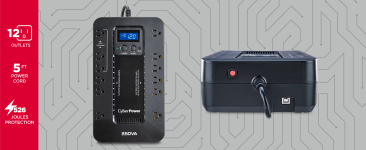I thought maybe the first time I saw that in one of your posts above, it was a simple typo. But since you used it again, I thought I would do some clarifying to avoid some possible confusion for others.
It is "AVR" not AVG. AVR, or automatic voltage "regulation" is actually the most important feature of a "good" "UPS with AVR". As I mentioned way back in Post #11, it is the protection from power anomalies that a "good" UPS with AVR provides. Backup power during a full power outage is only a minor bonus feature - the icing on the cake, if you will.
A good surge and spike protector (SSP) is better than nothing but we must remember, a surge and spike protector is little more than a fancy and expensive extension cord as they do absolutely nothing for abnormal low voltage events like dips (opposite of spikes) and sags (opposite of surges), or long duration sags (brownouts) - any of which can cause our electronics to suddenly stop, resulting in possible data corruption. And for "extreme" surges and spikes, a surge and spike protector simply kills power (if working properly) to our components. That's hardly good for our computer, drives, or data.
***
Here's a very real example of how having a "good" UPS with AVR can save the day, and maybe $1000s!
A couple years ago. I came home after dinner one evening to hear all my UPS (I have one on each computer and my home theater system) were beeping. Yet I could see by the lights and the correct time on the microwave oven, the power to the house was still on. That was weird. I live in
Tornado Alley so I am used to them beeping during power outages, but never like this. Surely all my UPS didn't fail at once?
Checking the UPS display panel for this computer, I saw the line-in voltage was 146VAC!

It's supposed to be 120VAC ± 10% or a maximum of 132VAC. 146VAC was way too much!
I quickly got out my multimeter and verified that my UPS readout was correct. Not good! I then measured the 220VAC outlet in the garage. It was showing 291.6VAC! Not good at all!
I called the power company, told them I was a technician and said if they didn't want to buy new refrigerators, washing machines, clothes dryers, AC compressors and HVAC blower motors for everyone in this neighborhood, they better get someone out right away!
That got their attention! Without exaggeration, within 15 minutes

they were at my door asking to go into my back yard to check my meter. Sure enough they verified the problem was not on my end, but theirs as the voltage at my drop was 292VAC (146VAC x 2). He got on the phone and within another 15 minutes, there was another technician in a cherry picker going up to look at the transformer on the pole feeding the houses on my block.
He quickly noted the "tap" on the transformer had fried. Transformer taps allow the technician to "tap" into the output side of a transformer at different output voltage points. This allows for the same model transformers to be used in different applications.
He moved the neighborhood's supply to an adjacent functional tap for a temporary fix until they could replace the 30 year old transformer. This setting was still a little too "hot" at 258VAC (129VAC single phase). But at least that was a safe level for our home electronics. All my UPS (and I) were happy.

About 2 weeks later they replaced the old transformer with a brand new one and now we are sitting at 120VAC.

There is no doubt in my mind, had my UPSs not yelled at me that night, these excessive voltages in our home appliances would have caused significant and expensive failures - with potential catastrophic, perhaps fatal results.




